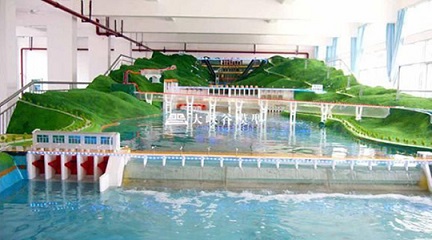
当前课程知识点:Finite Element Method (FEM) Analysis and Applications > 9、Finite element analysis of continuum structure (2) > 9.6 ANSYS analysis case of typical 3Dl problem > Video 9.6
返回《Finite Element Method (FEM) Analysis and Applications》慕课在线视频课程列表
返回《Finite Element Method (FEM) Analysis and Applications》慕课在线视频列表
同学们好
这一节我们将演示
典型空间问题的ANSYS计算分析过程
首先来看一下我们这个问题
从图中我们可以看出来
一共有8个节点
如果是采用四面体单元的话
一共有5个单元
前面我们所讨论的ANSYS操作过程
都是基于GUI也就是点菜单的方式来进行的
这一节我们将采用命令流的方式来进行操作
命令流是采用APDL语言
APDL语言可以实现
有限元模型的参数化
同时可以通过相应的一些函数
获取ANSYS数据库信息
并且可以进行数学运算
还包括矢量及矩阵的操作
同时我们也可以通过一些相应的do循环
或者是相应的判断语句
可以生成一系列的宏命令
我们首先来看一下我们对应的问题的命令流
首先我们可以发现
如果有带感叹号的
对于APDL语言的话,它是一个标注行
我们首先进行的这一行
我们指的是进入ANSYS前处理
对应的这个ET
这个命令就是定义相应的单元类型
也就是1号单元我们定义成185号单元的形式
对应的MP是定义相应的1号材料的弹性模量
是等于1e10
1号材料的泊松比是0.25
对应的我们就可以定义相应的节点
根据坐标的形式输入节点号
那我们可以看出来
这是1,2,3,4节点
我们可以发现
1,2,3,4节点跟对应的5,6,7,8节点
可以通过复制的方式
就是坐标偏移量从(0,0,0.6)
进行相应的偏值,我们就可以通过复制完成
我们创建了相应的1-8号节点之后
我们就可以根据前面的单元编号
和节点连接关系
我们就可以创建出对应的单元
这一部分我们就完成了ANSYS的有限元模型
接下来我们就可以再输入它的边界条件
7号、8号节点在z方向上要施加100000N的力
我们可以在7、8号节点施加100000N的力
这个命令指的是对节点1和节点2施加固定约束
节点5和节点6施加相应的固定约束
这样我们就把边界条件设置完毕
然后我们就可以求解
接下来我们就可以进入后处理
这个命令是计算相应的变形位移显示
还有这个命令是给出各个节点的位移值
这就是我们对应的命令流
我们这个对应的命令流
我们把它用记事本打开
我们可以把它写成记事本的形式
我们进入ANSYS
命令流的方式我们可以直接在
命令流的输入窗口里直接粘贴
我们可以看出来
我们就完成了整个ANSYS的计算分析过程
我们可以发现
我们计算出来的x,y,z方向的位移量
在3,4,7,8号节点跟前面
用MATLAB计算得出的结果是一致的
我们也可以直接通过支反力的List
看看它相应的支反力的情况
支反力的结果也跟前面MATLAB求出的结果一致
当然,有同学会问
命令流的形式那么复杂
我们应该怎样记住相应的命令
它对应的参数应该怎么去表达
我们可以通过帮助文件
比如说我们刚刚查一个命令“ET”
也就是定义相应的单元形式
我们可以看到ET
第一个也就是我们所说的单元类型号ITYPE
第二个就是我们所定义的
刚才我们定义的单元是Solid185号单元
那么我们把185号单元定义在这里
也就是在这
我们可以直接地定义
后面的这些我们可以不用管
我们可以看出来
关键的是
相应的这些命令流对应的一些参数
我们可以从帮助文件中找到
另外一方面就是
我们所有的这些菜单操作和相应的操作
我们其实可以通过log命令
也就是它所有的操作都可以在日志文件中找到
我们可以看到这就是刚才
我们所有操作的日志文件
那么最后一个就是我们刚才用菜单操作的
直接显示支反力的命令
我们再把它复制一下
把它粘贴上去
可以看出来
我们就直接获得了支反力的显示列表的结果
好的,谢谢大家
同学们,这一讲的内容就是这些
我们下一讲再见
-Finite element, infinite capabilities
--Video
-1.1 Classification of mechanics:particle、rigid body、deformed body mechanics
--1.1 Test
-1.2 Main points for deformed body mechanics
--1.2 Test
-1.3 Methods to solve differential equation solving method
--1.3 Test
-1.4 Function approximation
--1.4 Test
-1.5 Function approximation defined on complex domains
--1.5 Test
-1.6 The core of finite element: subdomain function approximation for complex domains
--1.6 Test
-1.7 History and software of FEM development
--1.7 Test
-Discussion
-Homework
-2.1 Principles of mechanic analysis of springs
--2.1 Test
-2.2 Comparison between spring element and bar element
--2.2 Test
-2.3 Coordinate transformation of bar element
--2.3 Test
-2.4 An example of a four-bar structure
--2.4 Test
-2.5 ANSYS case analysis of four-bar structure
--ANSYS
-Discussion
-3.1 Mechanical description and basic assumptions for deformed body
--3.1 Test
-3.2 Index notation
--3.2 Test
-3.3 Thoughts on three major variables and three major equations
--3.3 Test
-3.4 Test
-3.4 Construction of equilibrium Equation of Plane Problem
-3.5 Test
-3.5 Construction of strain-displacement relations for plane problems
-3.6 Test
-3.6 Construction of constitutive relations for plane problems
-3.7 Test
-3.7 Two kinds of boundary conditions
- Discussion
-- Discussion
-4.1 Test
-4.1 Discussion of several special cases
-4.2 Test
-4.2 A complete solution of a simple bar under uniaxial tension based on elastic mechanics
-4.3 Test
-4.3 The description and solution of plane beam under pure bending
-4.4 Test
-4.4 Complete description of 3D elastic problem
-4.5 Test
-4.5 Description and understanding of tensor
-Discussion
-5.1 Test
-5.1Main method classification and trial function method for solving deformed body mechanics equation
-5.2 Test
-5.2 Trial function method for solving pure bending beam: residual value method
-5.3 Test
-5.3How to reduce the order of the derivative of trial function
-5.4 Test
-5.4 The principle of virtual work for solving plane bending beam
-5.5 Test
-5.5 The variational basis of the principle of minimum potential energy for solving the plane bending
-5.6 Test
-5.6 The general energy principle of elastic problem
-Discussion
-6.1Test
-6.1 Classic method and finite element method based on trial function
-6.2 Test
-6.2 Natural discretization and approximated discretization in finite element method
-6.3 Test
-6.3 Basic steps in the finite element method
-6.4 Test
-6.4 Comparison of classic method and finite element method
-Discussion
-7.1 Test
-7.1 Construction and MATLAB programming of bar element in local coordinate system
-7.2 Test
-7.2 Construction and MATLAB programming of plane pure bending beam element in local coordinate syste
-7.3 Construction of three-dimensional beam element in local coordinate system
-7.4 Test
-7.4 Beam element coordinate transformation
-7.5 Test
-7.5 Treatment of distributed force
-7.6 Case Analysis and MATLAB programming of portal frame structure
-7.7 ANSYS case analysis of portal frame structure
-8.1 Test
-8.1 Two-dimensional 3-node triangular element and MATLAB programming
-8.2 Test
-8.2 Two-dimensional 4-node rectangular element and MATLAB programming
-8.3 Test
-8.3 Axisymmetric element
-8.4 Test
-8.4 Treatment of distributed force
-8.5 MATLAB programming of 2D plane rectangular thin plate
-8.6 Finite element GUI operation and command flow of a plane rectangular thin plate on ANSYS softwar
-Discussion
-9.1 Three-dimensional 4-node tetrahedral element and MATLAB programming
-9.2 Three-dimensional 8-node hexahedral element and MATLAB programming
-9.3 Principle of the isoparametric element
-9.4Test
-9.4Numerical integration
-9.5 MATLAB programming for typical 2D problems
-9.6 ANSYS analysis case of typical 3Dl problem
-Discussion
-10.1Test
-10.1Node number and storage bandwidth
-10.2Test
-10.2 Properties of shape function matrix and stiffness matrix
-10.3Test
-10.3 Treatment of boundary conditions and calculation of reaction forces
-10.4Test
-10.4 Requirements for construction and convergence of displacement function
-10.5Test
-10.5C0 element and C1 element
-10.6 Test
-10.6 Patch test of element
-10.7 Test
-10.7 Accuracy and property of numerical solutions of finite element analysis
-10.8Test
-10.8 Error and average processing of element stress calculation result
-10.9 Test
-10.9 Error control and the accuracy improving method of h method and p method
-Discussion
-11.1 Test
-11.1 1D high-order element
-11.2 Test
-11.2 2D high-order element
-11.3 Test
-11.3 3D high-order element
-11.4 Test
-11.4 Bending plate element based on thin plate theory
-11.5 Test
-11.5 Sub-structure and super-element
-12.1Test
-12.1 Finite element analysis for structural vibration: basic principle
-12.2 Test
-12.2 Case of finite element analysis for structural vibration
-12.3 Test
-12.3 Finite element analysis for elastic-plastic problems: basic principle
-12.4 Test
-12.4 Finite element analysis for elastic-plastic problems: solving non-linear equations
-Discussion
-13.1 Test
-13.1 Finite element analysis for heat transfer: basic principle
-13.2 Test
-13.2 Case of finite element analysis for heat transfer
-13.3 Test
-13.3 Finite element analysis for thermal stress problems: basic principle
-13.4 Test
-13.4 Finite element analysis for thermal stress problems: solving non-linear equation
-Discussion
-2D problem: finite element analysis of a 2D perforated plate
-3D problem: meshing control of a flower-shaped chuck
-Modal analysis of vibration: Modal analysis of a cable-stayed bridge
-Elastic-plastic analysis: elastic-plastic analysis of a thick-walled cylinder under internal pressur
-Heat transfer analysis: transient problem of temperature field during steel cylinder cooling process
-Thermal stress analysis: temperature and assembly stress analysis of truss structure
-Probability of structure: Probabilistic design analysis of large hydraulic press frame
-Modeling and application of methods: Modeling and analysis of p-type elements for plane problem




